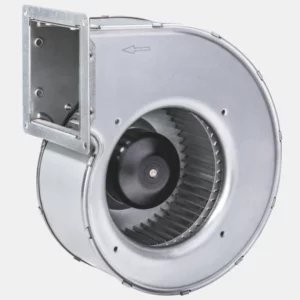Silent centrifugal fans, also known as quiet centrifugal fans, are designed to operate with reduced noise levels compared to standard centrifugal fans. They are commonly used in applications where noise control is important, such as residential buildings, offices, libraries, hospitals, and other noise-sensitive environments.
Here are some types of silent centrifugal fans:
- Low-Noise Centrifugal Fans: These fans are specifically designed with noise reduction features to minimize noise levels during operation. They may incorporate advanced aerodynamics, precision balancing, and vibration-dampening technologies to achieve quieter performance.
- Acoustic Enclosure Centrifugal Fans: Some centrifugal fans are enclosed within specially designed acoustic enclosures or cabinets. These enclosures are lined with sound-absorbing materials, such as foam or insulation, to reduce noise transmission. The enclosure helps contain the noise generated by the fan, resulting in quieter operation.
- In-Line Silencers: In-line silencers, also known as duct silencers or sound attenuators, can be used with centrifugal fans to further reduce noise. These silencers are installed in the ductwork or ventilation system, and they feature sound-absorbing materials that attenuate the noise generated by the fan as the air passes through.
- Variable Speed Centrifugal Fans: By using centrifugal fans with variable speed controls, noise levels can be reduced. The fan speed can be adjusted to match the required airflow, and running the fan at lower speeds often results in quieter operation.
- Fan Silencers: Fan silencers, sometimes called inlet or outlet silencers, are specifically designed attachments that can be added to the inlet or outlet of a centrifugal fan. These silencers help to reduce noise by attenuating the sound waves produced by the fan. They are particularly effective at reducing high-frequency noise.
It’s important to note that the specific type of silent centrifugal fan needed will depend on the noise control requirements and the characteristics of the application. Factors such as the desired noise reduction level, airflow capacity, pressure requirements, and space limitations should be considered when selecting the appropriate silent centrifugal fan for a given application. Consulting with a knowledgeable HVAC professional or acoustic engineer can help in determining the most suitable fan type for specific noise control needs.
How to choose the silent centrifugal fan you need ?
Choosing the right silent centrifugal fan for your needs involves considering several important factors.
Here are some key steps to help you in the selection process:
- Noise Requirements: Determine the specific noise level requirements for your application. Consider the permissible noise levels in the environment and any applicable regulations or standards. This will help you establish the maximum allowable noise level for the fan.
- Airflow and Pressure Requirements: Determine the required airflow rate and static pressure for your application. Calculate or estimate the airflow volume and pressure drop in the system to ensure that the selected fan can meet the necessary ventilation or cooling requirements.
- Efficiency: Consider the energy efficiency of the fan. Look for fans with high efficiency ratings, as they not only contribute to energy savings but also tend to generate less noise. Look for fans that comply with energy efficiency standards or certifications, such as ENERGY STAR.
- Size and Space Constraints: Assess the available space for fan installation. Measure the available dimensions and consider any space limitations, such as obstructions or clearance requirements. Ensure that the chosen fan can fit within the allocated space.
- Noise Ratings and Specifications: Consult the manufacturer’s specifications and technical data sheets for the silent centrifugal fans you are considering. Look for information on noise levels, such as sound power levels or sound pressure levels (in decibels). Compare the noise ratings of different fan models to identify the quieter options.
- Noise Reduction Features: Evaluate the noise reduction features and technologies incorporated in the fan design. Look for features such as aerodynamic blades, vibration-dampening mounts, acoustic enclosures, or built-in silencers. These features can contribute to quieter operation.
- Variable Speed Control: Consider fans with variable speed control capabilities. These fans allow you to adjust the fan speed to match the required airflow, which can help in reducing noise levels during periods of lower demand.
- Expert Advice: If you are uncertain about the selection process or have specific noise control requirements, consider consulting with HVAC professionals or acoustic engineers. They can provide guidance and expertise to help you choose the most suitable silent centrifugal fan for your application.
By considering these factors and conducting thorough research, you can make an informed decision when selecting a silent centrifugal fan that meets your noise control needs while providing the necessary airflow and performance for your specific application.
